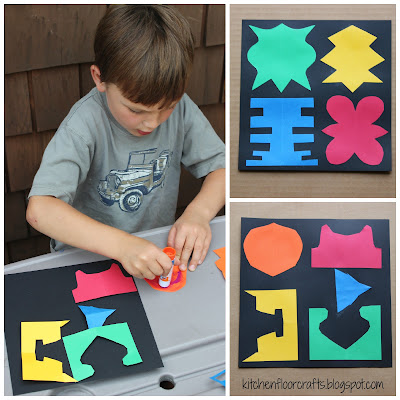We're often doing math at home, sometimes as a project or game but more often it is just part of our daily experiences and conversations.
This week we started exploring symmetry. To introduce the topic, we explored it in four different ways.
Symmetry is a geometry term. The symmetry we explored focused on the idea that a shape or object can have a line of symmetry. When an object is folded in half, or you visualize a line going down the center of an object, you can see that the other half exactly matches or mirrors the first half.
For the first two explorations we used the following materials: white paper, colored card stock in a variety of colors, scissors, and glue sticks.
1) Folding Shapes
Before beginning the project, I cut several different shapes out of white photocopy paper: squares, triangles, and rectangles.
I started by showing Big Brother how if we folded the square in half, the two halves matched. I explained that the matched halves meant the shape had symmetry and the fold line was a line of symmetry.
We then worked on folding the other shapes to see where the line of symmetry was, and even started seeing if we could fold shapes in more than one way to find multiple lines of symmetry. I cut out a few more shapes (star, tree, butterfly) and we looked at where the line of symmetry was on these shapes as well.
2) Cutting Shapes
After we had explored folding shapes, we explored cutting shapes to find symmetry.
First we folded the small colorful squares in half. We then free cut out any shape we wanted, taking care to keep part of the fold line intact.
When we opened the shape we could see how the two halves matched and that the fold line was now the line of symmetry. After we had cut out several shapes, we glued the pieces to a larger square of black card stock to create a collage.
Big Brother was able to go through after the fact and show me all the lines of symmetry on both collages.
3. Build with Legos
A while ago while watching Big Brother play with his Legos, I realized how he was using symmetry in his building without even knowing it.
After we finished our collages, I had him get out a box of Legos so I could show him one simple way to use the Legos to create symmetry.
We each took one medium sized flat piece and put a line down the middle of the plate with another Lego. We then used the Legos to match the colors and shapes we were putting on either side of the line. For the first round of building, we kept the pieces flat.
We both worked until we filled our pieces. I'm looking forward to seeing Big Brother expand on this idea the next time we build.
4. Look for Symmetry in Nature
Our last symmetry exploration involved getting outside. Symmetry is everywhere in nature. We began exploring outside to see what objects we could find that had a line of symmetry.
On our short walk we discovered ferns, flowers, and leaves that all had a line of symmetry.
Big Brother especially found it interesting that the human face (and body) also have symmetry. My plan is we can keep looking for things with symmetry the next time we're out and about, whether it be in the woods or in town.
I can't wait to see what other Cool Maths concepts different bloggers come up with. Check the linky below for other great posts, or if you're a blogger add your own math post!
This post may also have been shared at some of these terrific link parties.









Peakles & I think this is great - we have been looking at symmetrical patterns earlier this morning! Thank you for joining in with the Cool Maths for Cool Kids series! :)
ReplyDeleteThanks Peakle Pie! And thanks for initiating this Blog Series, so many amazing ideas!
Delete